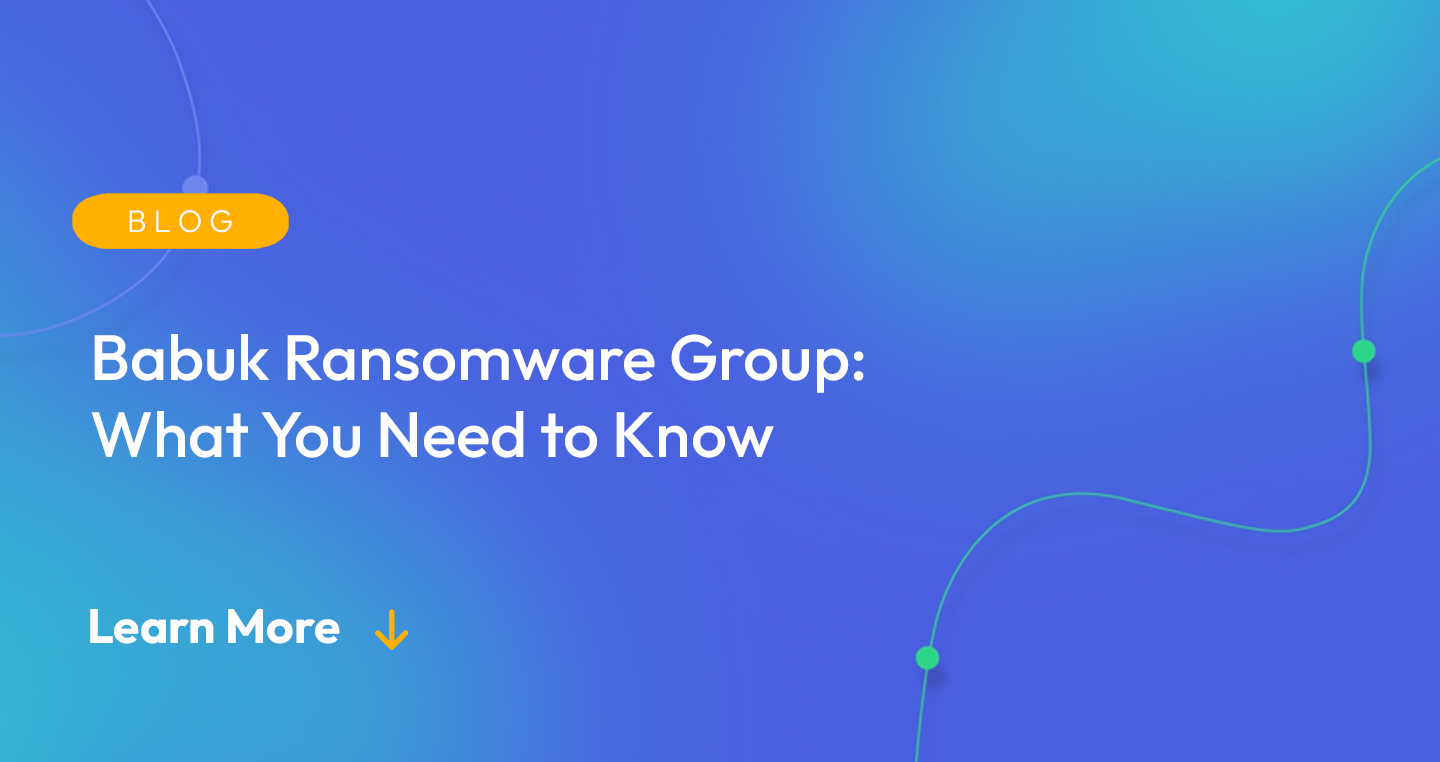
The Babuk ransomware group emerged into the world of illicit activities relatively recently in 2021. Since then, they have conducted a series of high-profile ransomware attacks across various industries.
The group targeted organizations across a wide range of sectors, including healthcare, logistics, and professional services, leaving a trail of encrypted files and ransom demands in its wake.
Evolution of Babuk Ransomware Group
In the dynamic landscape of cyber threats, new players continually emerge, each bringing their unique brand of chaos and disruption. One such entrant that has quickly gained infamy is the Babuk ransomware group. A relatively recent addition to the cybercrime scene, Babuk has quickly risen to prominence with its audacious attacks and ruthless strategies.
Babuk’s Change from Single to Double Extortion
The evolution of Babuk has been marked by its rapid adaptation and escalation of tactics. Initially, the group focused on a more traditional ransomware approach, encrypting victims’ files and demanding a ransom for decryption. But within months of their emergence, Babuk adopted the increasingly common “double extortion” tactic. In addition to encrypting data, they began exfiltrating sensitive information, threatening to publish it on their leak site if the ransom wasn’t paid, thereby adding reputational damage to the potential consequences of an attack.
Babuk’s Retirement and Reemergence
In a surprising twist, Babuk announced their retirement from ransomware attacks later in 2021. However, this proved short-lived. Within weeks, the group resurfaced, this time with a new focus on cyber-espionage alongside their ransomware activities. This shift underscored the group’s agility and willingness to pivot their approach in response to changing circumstances and opportunities.
The story of Babuk is a testament to the rapidly evolving nature of cyber threats. Today’s threat landscape is not static but continually transforming, with groups like Babuk constantly adapting and refining their tactics.
How the Babuk Ransomware Group Operates: Decoding the Tactics
One of the defining characteristics of Babuk’s modus operandi is its “big game hunting” approach. Rather than targeting individuals or small businesses, Babuk tends to focus on large organizations with the resources to pay hefty ransoms. They meticulously research and select their targets, often choosing entities with critical operational data that would compel quick ransom payments to prevent disruptions.
Like many ransomware groups, Babuk’s attacks typically begin with a phishing campaign or exploiting known vulnerabilities in software systems. Once they gain an initial foothold, they proceed with lateral movement across the network, escalating privileges and identifying critical data and backup systems.
In line with their double extortion strategy, Babuk exfiltrates sensitive data before launching the ransomware attack. This data is then used as leverage, with the group threatening to publicly release it if the ransom isn’t paid. Their ransomware, known for its robust encryption algorithms, locks down victims’ files, effectively bringing operations to a halt until a ransom is paid or the files are recovered through other means.
Interestingly, Babuk has been known to engage with their victims and cybersecurity professionals in online forums, sometimes offering “advice” on security weaknesses they exploited during their attacks. While this may seem counterintuitive, it is in line with them presenting themselves as a non-malicious group that helps organizations by pointing out security flaws.
The tactics employed by the Babuk ransomware group underscore the importance of maintaining robust, multi-faceted security measures. Regular system patching, strong email security, frequent backups, and employee cybersecurity training form the essential pillars of a defense strategy capable of mitigating the threat posed by groups like Babuk.
Babuk Ransomware Group’s Notable Attacks and Impacts
The Babuk ransomware group, despite its relatively short tenure in the cybercrime landscape, has already left an indelible mark through a series of high-profile attacks. These attacks have not only led to considerable financial losses but have also caused significant operational disruptions.
Extensive Data Theft and Operational Disruption
One of the most notable attacks by the Babuk group targeted a major international corporation, leading to a shutdown of operational systems and extensive data theft. The ransom demand was in the millions, reflecting the group’s tactic of targeting large organizations with substantial resources. This attack highlighted Babuk’s capability to infiltrate complex network systems and exfiltrate large volumes of sensitive data.
Leaking Sensitive Information
In another high-profile attack, Babuk targeted a city’s police department, gaining access to confidential law enforcement data. This included sensitive information such as internal memos, arrest reports, and personal information of officers and arrestees. This data was later leaked on their shaming site when the ransom was not paid, leading to serious reputational damage and potential legal repercussions for the police department.
Halting Healthcare Services
The group also made headlines with a significant attack on a major healthcare provider. This attack resulted in the theft of patient data and caused substantial disruption to healthcare services, leading to a public outcry and regulatory scrutiny.
What are the Other Risks Associated with Ransomware Attacks?
The impacts of these attacks extend beyond the immediate operational disruption and financial loss from ransom payments including:
- Potential violation of privacy laws
- Reputational damage
- Loss of customer trust
It’s also important to note that the Babuk ransomware group, like many other cybercriminal organizations, is continuously evolving its tactics and improving its capabilities, making it an ongoing threat to organizations across various sectors.
Fortifying Your Defenses: How to Protect Your Organization from Babuk’s Threats
In the face of the rising threat posed by the Babuk ransomware group, it is essential for organizations to adopt a proactive approach to cybersecurity. By understanding Babuk’s tactics and implementing robust preventive measures, businesses can significantly mitigate the risk of falling victim to these malicious actors. Here are some key strategies to protect your organization from Babuk’s threats.
Implement Advanced Threat Intelligence Solutions:
Cyber threat intelligence platforms, like our SaaS solution, provide real-time monitoring and alerts for emerging threats. By leveraging advanced machine learning algorithms, these platforms can identify patterns of suspicious activity and detect ransomware attacks in the early stages, often before they can inflict significant damage.
Regular Data Backups and Restoration Testing:
Regularly backing up data is an essential defense against ransomware attacks. By storing backups in a secure, off-site location, organizations can ensure that they can restore their systems quickly in the event of an attack. It’s also crucial to test these backups regularly to ensure that data can be restored effectively when needed.
Rigorous Security Training:
Babuk often gains initial access to networks through phishing emails or exploiting weak credentials. Regularly training employees to recognize and report phishing attempts, and enforcing strong password policies across your organization can significantly reduce the risk of an attack.
Frequent Security Audits:
Regular security audits can help organizations identify potential vulnerabilities in their systems and patch them before they can be exploited. This includes ensuring that all software and systems are up-to-date with the latest security patches.
Incident Response Planning:
Having a well-documented and tested incident response plan can significantly reduce the impact of a ransomware attack. This plan should include steps for isolating affected systems, mitigating the spread of the ransomware, communicating with stakeholders, and restoring systems from backups.
Multi-Factor Authentication (MFA):
Implementing MFA across all systems can provide an additional layer of security, preventing unauthorized access even if an attacker has obtained a user’s credentials.
By adopting these measures, organizations can significantly bolster their defenses against the Babuk ransomware group, and other similar threats. Cybersecurity is a constantly evolving field, and staying one step ahead of threat actors requires continuous vigilance, investment in advanced security technologies, and a culture of cybersecurity awareness throughout the organization.
Ransomware Readiness with Flare
In an ever-shifting digital landscape, monitoring new threats is of utmost importance. Understanding Babuk ransomware group’s TTPs can help mitigate potential threats.
Flare monitors illicit communities across the clear & dark web and illicit Telegram channels for cybercriminal activity, including ransomware blogs. Sign up for a free trial to check out what ransomware readiness could look like.





